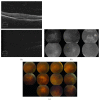Presentation of Ocular Syphilis in a HIV-Positive Patient with False-Negative Serologic Screening
- PMID: 30863648
- PMCID: PMC6377954
- DOI: 10.1155/2019/8191724
Presentation of Ocular Syphilis in a HIV-Positive Patient with False-Negative Serologic Screening
Abstract
Purpose: The ocular sequelae of syphilis are devastating and may cause blindness. The ambiguous nature of its ocular manifestations makes syphilis difficult to detect. Though uncommon, the rise of syphilis in the United States requires a renewed understanding of its ophthalmic presentation to prevent devastating outcomes. We present this case to raise awareness for the increasing prevalence of ocular syphilis and appropriate serologic testing.
Observations: We describe a 65-year-old HIV-positive male with worsening retinitis, uveitis, and rapid visual loss. Initial lab results showed a nonreactive rapid plasma reagin (RPR) for syphilis. However, subsequent Treponema pallidum antibody testing was positive 48 hours after initial false-negative serologic screening. The patient had a rapid and successful recovery following treatment with penicillin.
Conclusions and importance: The incidence of syphilis is on the rise once again, and patients living with HIV are at increased risk. Ocular syphilis should be considered in susceptible populations in the clinical setting of retinitis, uveitis, and worsening visual loss with unknown cause. In addition, retesting for syphilis will decrease the prevalence of false-negative results, especially in patients with high clinical suspicion.
Figures



Similar articles
-
Ocular syphilis on the rise: a 10-year analysis from 2010 to 2020.Int Ophthalmol. 2023 Dec;43(12):4419-4426. doi: 10.1007/s10792-023-02759-2. Epub 2023 Sep 29. Int Ophthalmol. 2023. PMID: 37773472
-
Ocular Syphilis: Our Experience in Selayang Hospital, Malaysia.Cureus. 2022 Jul 8;14(7):e26655. doi: 10.7759/cureus.26655. eCollection 2022 Jul. Cureus. 2022. PMID: 35949800 Free PMC article.
-
[A Case of Congenital Syphilis and Prozone Phenomenon].Mikrobiyol Bul. 2019 Jul;53(3):336-342. doi: 10.5578/mb.68172. Mikrobiyol Bul. 2019. PMID: 31414635 Turkish.
-
[Ocular syphilis].J Fr Ophtalmol. 2014 Apr;37(4):329-36. doi: 10.1016/j.jfo.2013.12.006. Epub 2014 Mar 18. J Fr Ophtalmol. 2014. PMID: 24655791 Review. French.
-
Ocular syphilis.Curr Opin Ophthalmol. 2014 Nov;25(6):513-8. doi: 10.1097/ICU.0000000000000099. Curr Opin Ophthalmol. 2014. PMID: 25237932 Review.
Cited by
-
Prognostic effect of HIV on visual acuity in ocular syphilis: a systematic review.Eye (Lond). 2023 Oct;37(15):3271-3281. doi: 10.1038/s41433-023-02504-0. Epub 2023 Mar 21. Eye (Lond). 2023. PMID: 36944709 Free PMC article.
-
Syphilitic uveitis in HIV-positive patients: report of a case series, treatment outcomes, and comprehensive review of the literature.Int J Ophthalmol. 2023 Aug 18;16(8):1250-1259. doi: 10.18240/ijo.2023.08.10. eCollection 2023. Int J Ophthalmol. 2023. PMID: 37602346 Free PMC article.
References
-
- Centers for Disease Control and Prevention. Sexually Transmitted Disease Surveillance, 2015. Atlanta, GA, USA: U.S. Department of Health and Human Services; 2016.
-
- Centers for Disease Control and Prevention. Sexually Transmitted Diseases Treatment Guidelines, 2015. Atlanta, GA, USA: U.S. Department of Health and Human Services; 2016.
-
- Centers for Disease. Control and Prevention, U.S. Department of Health and Human Services, Discordant results from reverse sequence syphilis screening—five laboratories, United States, 2006–2010. Morbidity and Mortality Weekly Report. 2011;60:133–137. - PubMed
-
- Hoover K, Park I, Centers for Disease Control and Prevention Reverse sequence syphilis screening: an overview by CDC. July 2017. https://www.cdc.gov/std/syphilis/syphilis-webinar-slides.pdf.
Publication types
LinkOut - more resources
Full Text Sources
Miscellaneous

